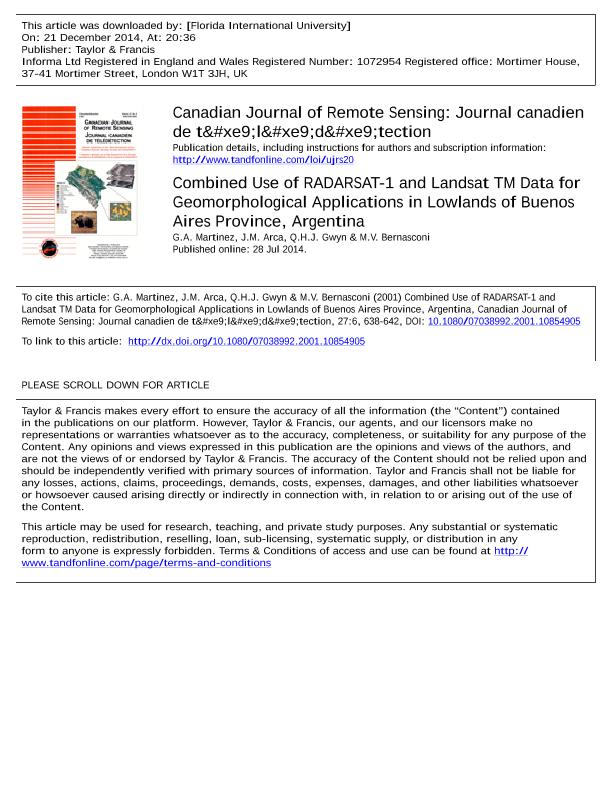Mostrar el registro sencillo del ítem
dc.contributor.author
Martinez Arca, Jorge

dc.contributor.author
Arca, J.M.
dc.contributor.author
Gwyn, Q.H.J.
dc.contributor.author
Bernasconi, M.V.
dc.date.available
2016-12-28T16:24:41Z
dc.date.issued
2014-07-28
dc.identifier.citation
Martinez Arca, Jorge; Arca, J.M.; Gwyn, Q.H.J.; Bernasconi, M.V.; Combined use of RADARSAT-1 and landsat TM data for geomorphological applications in lowlands of Buenos Aires Province, Argentina; Taylor & Francis; Canadian Journal Of Remote Sensing - (online); 27; 6; 28-7-2014; 638-642
dc.identifier.issn
1712-7971
dc.identifier.uri
http://hdl.handle.net/11336/10452
dc.description.abstract
The main objective of this research is to generate information to model the present and past geomorphology of the area. Image analysis techniques are among the best tools for geomorphological mapping in the area, since the main landforms (paleodunes and drainage features) are barely visible on the ground because of their low relief and dense grass cover. Wide Swath Mode Beam W2 RADARSAT-1 images were fused with a Landsat TM image. Three main geomorphic units were differentiated: Tandilia Range, Aeolian Fringe (marginal to the Tandilia Range) and the Fluvio-Aeolian Plain. Best results were obtained from the integration of RADARSAT-1 during dry periods and Landsat data during wet periods, especially in the Fluvio-aeolian Plain. It corresponds to a landscape of very low relief (slope<1%) characterized by longitudinal and parabolic silt dunes and linked deflation ponds and lunettes. A drainage system made up of short subparallel streams is superimposed on the relic landscape. The aeolian landforms had never been recognized until these images were analyzed because of the topographic and soil moisture contrasts, which provide the most detailed information. The Landsat TM data provide excellent information concerning land use, however the geomorphologic landforms were only recognized on the RADARSAT images.
dc.description.abstract
L'objectif principal de cette recherche est de générer une information pour modéliser la géomorphologie actuelle et ancienne de la région. Les techniques d'analyse d'images constituent l'un des meilleurs outils pour la cartographie géomorphologique dans la région étant donné que les principales formes de terrain (paléodunes et caractéristiques de drainage) sont peu visibles sur le terrain en raison du faible relief et du couvert herbeux dense. Des images RADARSAT-1 en mode faisceau 2 large ont été fusionnées avec une image Landsat TM. Trois grandes unités géomorphologiques ont été différenciées: la chaîne Tandilia, la frange éolienne (marginale par rapport à la chaîne Tandilia) et la plaine fluvio-éolienne. Les meilleurs résultats ont été obtenus par l'intégration d'images RADARSAT-1 durant les périodes sèches et de l'image Landsat durant les périodes humides, spécialement dans la plaine fluvio-éolienne. La zone correspond à une topographie de relief très plat (pente<1%) caractérisé par des dunes longitudinales et paraboliques silteuses et des cuvettes de déflation et des lunettes associées. Un système de drainage constitué de rigoles sous-parallèles courtes est superposé à la topographie relique. Les formes éoliennes de terrain n'avaient jamais été décelées avant que ces images ne soient analysées grâce au contraste entre la topographie et l'humidité du sol qui apporte une information plus détaillée. Les données Landsat TM ont fourni une information utile sur l'utilisation du sol alors que les formes géomorphologiques ne pouvaient être reconnues que sur les images RADARSAT.
dc.format
application/pdf
dc.language.iso
eng
dc.publisher
Taylor & Francis

dc.rights
info:eu-repo/semantics/openAccess
dc.rights.uri
https://creativecommons.org/licenses/by-nc-sa/2.5/ar/
dc.subject
Radarsat
dc.subject
Landsat Tm
dc.subject
Geomorphology
dc.subject
Argentina
dc.subject.classification
Sensores Remotos

dc.subject.classification
Ingeniería del Medio Ambiente

dc.subject.classification
INGENIERÍAS Y TECNOLOGÍAS

dc.title
Combined use of RADARSAT-1 and landsat TM data for geomorphological applications in lowlands of Buenos Aires Province, Argentina
dc.type
info:eu-repo/semantics/article
dc.type
info:ar-repo/semantics/artículo
dc.type
info:eu-repo/semantics/publishedVersion
dc.date.updated
2016-10-07T20:17:00Z
dc.journal.volume
27
dc.journal.number
6
dc.journal.pagination
638-642
dc.journal.pais
Reino Unido

dc.journal.ciudad
Londres
dc.description.fil
Fil: Martinez Arca, Jorge. Universidad Nacional de Mar del Plata. Facultad de Ciencias Exactas y Naturales. Instituto de Geología de Costas y del Cuaternario; Argentina. Consejo Nacional de Investigaciones Científicas y Técnicas; Argentina
dc.description.fil
Fil: Arca, J.M.. Universidad Nacional de Mar del Plata. Facultad de Ciencias Exactas y Naturales. Instituto de Geología de Costas y del Cuaternario; Argentina
dc.description.fil
Fil: Gwyn, Q.H.J.. University Of Sherbrooke; Canadá
dc.description.fil
Fil: Bernasconi, M.V.. Universidad Nacional de Mar del Plata. Facultad de Ciencias Exactas y Naturales. Instituto de Geología de Costas y del Cuaternario; Argentina
dc.journal.title
Canadian Journal Of Remote Sensing - (online)

dc.relation.alternativeid
info:eu-repo/semantics/altIdentifier/url/http://www.tandfonline.com/doi/abs/10.1080/07038992.2001.10854905
dc.relation.alternativeid
info:eu-repo/semantics/altIdentifier/doi/http://dx.doi.org/10.1080/07038992.2001.10854905
Archivos asociados
